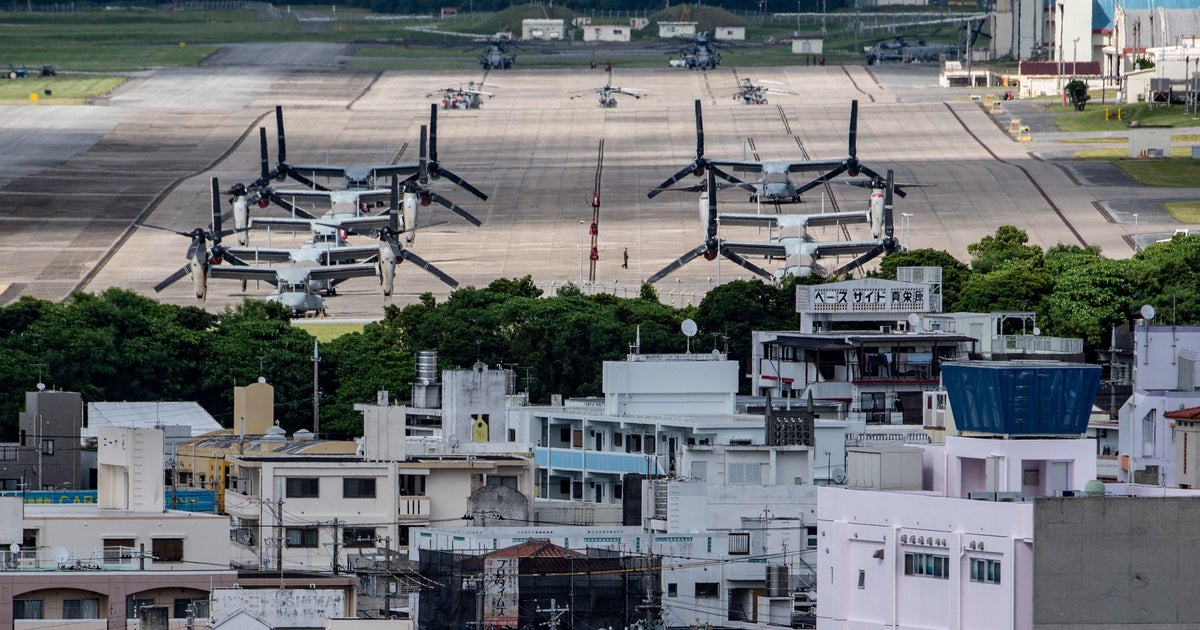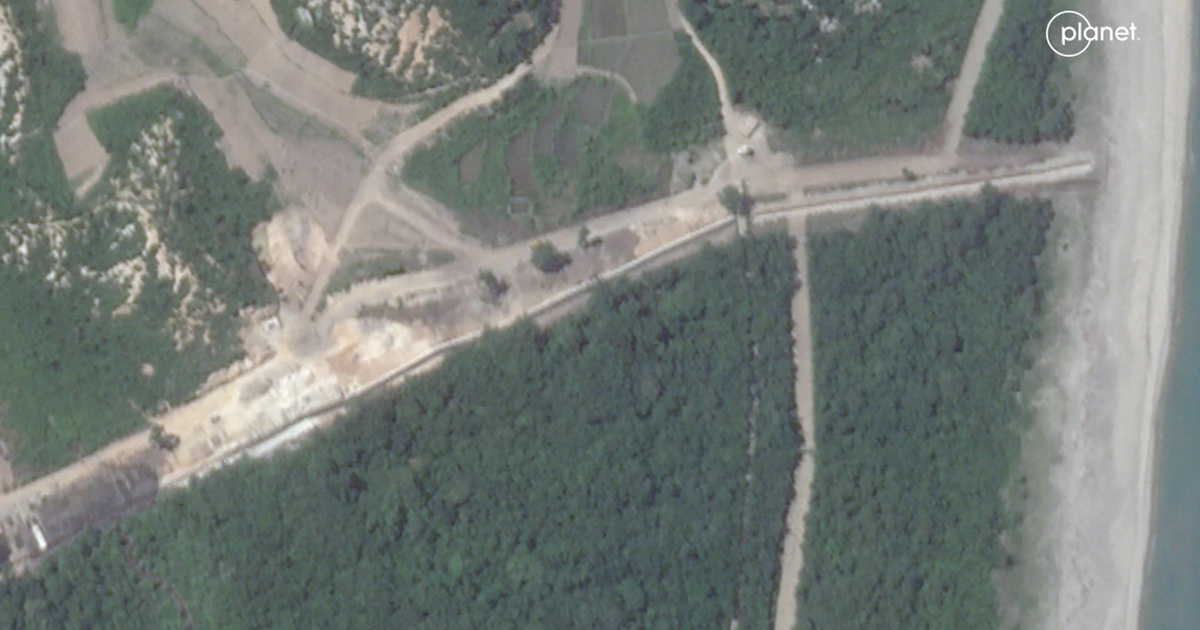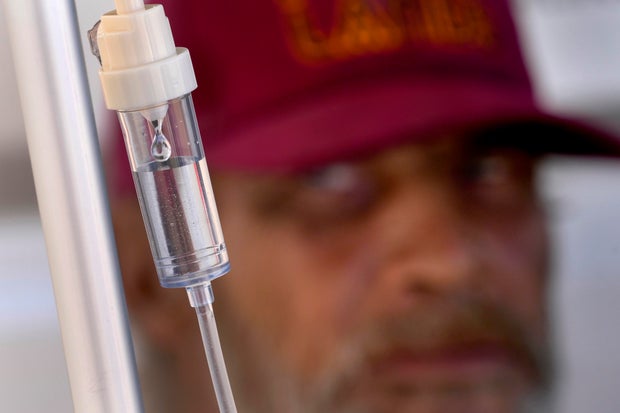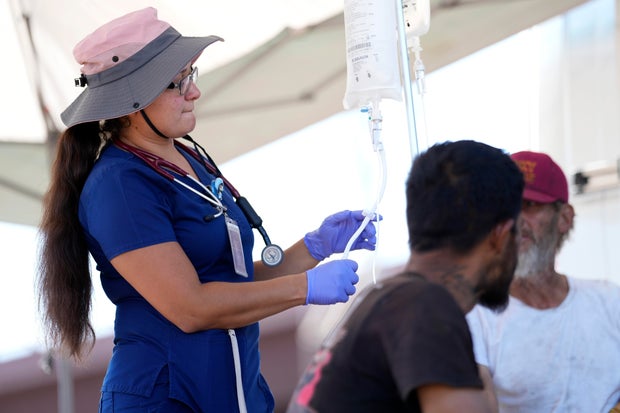CBS News
North Korea’s first 2024 missile test was conducted with remote U.S. targets in the region in mind, analysts say

Seoul, South Korea — North Korea on Monday said it flight-tested a solid-fuel intermediate-range missile tipped with a hypersonic warhead as it pursues more powerful, harder-to-detect weapons designed to strike remote U.S. targets in the region.
The report by North Korea’s state media came a day after the South Korean and Japanese militaries detected the launch from a site near the North Korean capital of Pyongyang, in what was the North’s first ballistic test of 2024.
Ahn Young-joon / AP
The launch came two months after North Korea said it successfully tested engines for a new solid-fuel intermediate-range ballistic missile, which reflected a push to advance its lineup of weapons targeting U.S. military bases in Guam and Japan.
The North’s official Korean Central News Agency said Sunday’s launch was aimed at verifying the reliability of the missile’s solid-fuel engines and the maneuverable flight capabilities of the hypersonic warhead, which the report implied was an upgraded version of previous vehicles designed to perform intermediate-range strikes.
The report described the test as a success but didn’t provide details. It didn’t mention whether North Korean leader Kim Jong Un attended the test, which it said was part of the country’s regular weapons development activities and did not affect the security of neighbors.
South Korea’s Joint Chiefs of Staff said the missile flew about 620 miles before landing in the waters between the Korean Peninsula and Japan. The North’s existing intermediate-range ballistic missiles or IRBMs, including the Hwasong-12 that may be able to reach the U.S. military hub of Guam in the Pacific, are powered by liquid-fuel engines that are fueled up before launch and can’t stay fueled for long.
Missiles with built-in solid propellants can be made ready to launch faster and are easier to move and conceal, theoretically making it harder for adversaries to detect and preempt the launch.
The North has since 2021 also been testing hypersonic weapons designed to exceed five times the speed of sound. If perfected, such systems could potentially pose a challenge to regional missile defense systems because of their speed and maneuverability.
However, it’s unclear whether the North’s hypersonic vehicles consistently maintained a desired speed exceeding Mach 5 during tests in 2021 and 2022.
Pyongyang’s program’s progress
North Korea’s latest test showed it’s simultaneously trying to advance its hypersonic weapons and develop solid-fuel IRBMs as potential delivery systems, although Sunday’s launch would have been predominantly focused on evaluating the missile’s solid-fuel first-stage, said Chang Young-keun, a missile expert at South Korea’s Research Institute for National Strategy.
“In particular, a hypersonic missile with IRBM-level range would be an effective mean for evading U.S. missile defenses and striking Guam,” Chang said.
More flight tests are likely to come soon and raise the alarm of neighbors.
North Korea has test-fired its biggest missiles nearly straight up into the air to avoid neighbors’ territory. But the country is more likely to launch the new solid-fuel missile at a normal ballistic trajectory when testing it with a hypersonic warhead in the future, to verify the vehicle’s ability to glide and maneuver at desired speeds following separation from the booster, said Kim Dong-yub, a professor at the University of North Korean Studies in Seoul.
North Korea has flown the Hwasong-12 IRBMs over Japan three different times since 2017.
Lee Sung Joon, spokesperson of South Korea’s Joint Chiefs of Staff, said the military was analyzing the North’s latest test but declined to elaborate.
The South’s Defense Ministry demanded the North halt its ballistic testing activities that violate U.N. Security Council resolutions. It said the South Korean military was maintaining a firm joint defense posture with its U.S. allies and is ready to respond “overwhelmingly” in the event of a direct provocation by the North.
Hypersonic weapons were part of a wish-list of sophisticated military assets Kim Jong Un unveiled in 2021, along with multi-warhead missiles, spy satellites, solid-fuel intercontinental range ballistic missiles and submarine-launched nuclear missiles.
North Korean military scientists and engineers have been checking off Kim’s list of goals, testing for the first time last year a solid-fuel ICBM Hwasong-18, which added to the North’s arsenal of weapons targeting the U.S. mainland.
The North also launched its first military reconnaissance satellite in November and aims to launch three more satellites in 2024, described by Kim as crucial for monitoring U.S. and South Korean military activities and enhancing the threat of his nuclear-capable missiles.
Regional tensions intensifying
Tensions on the Korean Peninsula are at their highest point in years after Kim recently ramped up his weapons demonstrations. The United States and its allies Seoul and Tokyo responded by strengthening their combined military exercises and sharpening their nuclear deterrence strategies.
There are also concerns about an alleged arms cooperation between North Korea and Russia as they align in the face of separate, intensifying confrontations with Washington. In their latest sign of diplomacy, a North Korean delegation led by Kim’s foreign minister, Choe Sun Hui, arrived in Moscow on Sunday at the invitation of Russian Foreign Minister Sergey Lavrov, KCNA said. The report didn’t say what would be discussed.
The U.S. and South Korean governments have claimed that North Korea has been providing Russia with arms supplies, including artillery and missiles, to help prolong its invasion of Ukraine.
The Biden administration said it has evidence that missiles provided by North Korea to Russia had been used in the war in Ukraine. In a joint statement last week, the U.S., South Korea and their partners said the missile transfer supports Russia’s war of aggression and provides North Korea with valuable technical and military insights.
Koo Byoungsam, spokesperson of South Korea’s Unification Ministry, said Seoul is closely watching Choe’s visit to Russia and lamented that North Korea and Russia were allegedly “maintaining illegal cooperation activities, including arms exchanges” following Kim’s September visit to Russia for a summit with Russian President Vladimir Putin. Koo didn’t provide a specific answer when asked whether Choe could be working to set up a Putin visit to North Korea.
Both Moscow and Pyongyang have denied accusations about North Korean arms transfers to Russia.
Some experts say the North could try to dial up pressure in an election year for Seoul and Washington.
North Korea earlier this month fired artillery shells near the disputed western sea boundary with South Korea, prompting the South to conduct similar firing in return. Kim has also used a political conference last week to define South Korea as the North’s “principal enemy” and threatened to annihilate it if provoked.
CBS News
Meet the designer turning classic Venetian glass into modern art

Watch CBS News
Be the first to know
Get browser notifications for breaking news, live events, and exclusive reporting.
CBS News
Minnesota Vikings rookie Khyree Jackson dies in car accident

MINNEAPOLIS — Minnesota Vikings rookie Khyree Jackson died overnight in a car accident.
The Upper Marlboro, Maryland native played for Alabama and Oregon. He was drafted by the Vikings in April in round 4 as the 108th overall pick.
He was 24 years old.
“Our thoughts are with Khyree’s family, friends, teammates and coaches, as well as all the victims of this tragic accident,” the Vikings wrote on X.
Vikings head coach Kevin O’Connell said he was “crushed” by the news of Jackson’s death.
“In our short time together, it was evident Khyree was going to develop into a tremendous professional football player, but what was more impressive was his desire to become the best person he could be for his family and those around him,” O’Connell added.
The crash happened in Upper Marlboro shortly after 3 a.m. and involved three cars, according to Maryland state police. Investigators believe the driver of a silver Infiniti car tried to change lanes at a high rate of speed and struck the car that Jackson was in, as well as a Chevrolet Impala.
The two other occupants of Jackson’s car also died in the crash. The occupants of the other cars were not hurt.
Officials believe that alcohol could have been a contributing factor in the crash.
In a statement, the Minnesota Vikings say they have offered support to Jackson’s family, and are offering counseling and emotional support to the players who seek it.
This is a developing story. Check back with WCCO.com for more.
Note: The above video first aired on June 24, 2024.
CBS News
Street medics treat heat illnesses among homeless people as temperatures rise

Alfred Handley leaned back in his wheelchair alongside a major Phoenix freeway as a street medicine team helped him get rehydrated with an intravenous saline solution dripping from a bag hanging on a pole.
Cars whooshed by under the blazing 96-degree morning sun as the 59-year-old homeless man with a nearly toothless smile got the help he needed through a new program run by the nonprofit Circle the City.
“It’s a lot better than going to the hospital,” Handley said of the team that provides health care to homeless people. He’s been treated poorly at traditional clinics and hospitals, he said, more than six years after being struck by a car while he sat on a wall, leaving him in a wheelchair.
Circle the City, a non-profit that works in multiple cities and hospitals and treats about 9,000 people annually, introduced its IV rehydration program as a way to protect homeless people in Phoenix from life-threatening heat illness as temperatures regularly hit the triple-digits in America’s hottest metro.
Matt York / AP
Homeless people accounted for nearly half of the record 645 heat-related deaths last year in Maricopa County, which encompasses metro Phoenix. As summers grow warmer, health providers from San Diego to New York are being challenged to better protect homeless patients.
Dr. Liz Frye, vice chair of the Street Medicine Institute which provides training to hundreds of healthcare teams worldwide, said she didn’t know of groups other than Circle the City administering IVs on the street. The organization also distributes tens of thousands of water bottles each summer and tries to educate people about hot weather dangers.
“But if that’s what needs to happen to keep somebody from dying, I’m all about it,” Frye said.
Bringing care to people in need
The amount of people requiring treatment for heat illnesses is rising. The Boston Health Care for the Homeless Program, featured in last year’s book, “Rough Sleepers,” now sees patients with mild heat exhaustion in the summer after decades of treating people with frostbite and hypothermia during the winter, said Dr. Dave Munson, the street team’s medical director.
“It’s certainly something to worry about,” said Munson, noting that temperatures in Boston hit 100 degrees with 70% humidity during June’s heat wave. Homeless people, he said, are vulnerable to very hot and very cold weather not only because they live outside, but they often can’t regulate body temperature due to medication for mental illness or high blood pressure, or because of street substance use.
The Phoenix team searches for patients in homeless encampments in dry riverbeds, sweltering alleys and along the canals that bring water to the Phoenix area. About 15% are dehydrated enough for a saline drip.
Matt York / AP
“We go out every day and find them,” said nurse practitioner Perla Puebla. “We do their wound care, medication refills for diabetes, antibiotics, high blood pressure.”
Puebla’s street team ran across Handley and 36-year-old Phoenix native Phillip Enriquez near an overpass in an area frequented by homeless people because it’s near a facility offering free meals. Across the road was an encampment of tents and lean-tos along a chain-link fence.
Enriquez sat on a patch of dirt as Puebla started a drip for him. She also gave him a prescription for antibiotics and a referral to a dentist for his dental infection.
Living outside in Arizona’s broiling sun is hard, especially for people who may be mentally ill or use sedating drugs like fentanyl that make them less aware of their surroundings. Stimulants like methamphetamine contribute to dehydration, which can be fatal. Dr. Matt Essary, who works with Circle in the City’s mobile clinics, said the organization also often treats surface burns that can happen when a medical emergency or intoxication causes someone to fall on a sizzling sidewalk.
Matt York / AP
Temperatures this year have reached 115 degrees in metro Phoenix, where six heat-related deaths have been confirmed through June 22. Another 111 are under investigation, and the city is seeing an “increasing” number of patients with heat illnesses every year, according to Dr. Aneesh Narang, the assistant medical director of emergency medicine at Banner Medical Center-Phoenix, which treats many homeless people with heat stroke.
Narang’s staff works frequently with Circle the City, whose core mission is providing respite care, with 100 beds for homeless people not well enough to return to the streets after a hospital stay.
Extreme heat worldwide requires a dramatic response, said physician assistant Lindsay Fox, who cares for homeless people in Albuquerque, New Mexico, through an initiative run by the University of New Mexico’s School of Medicine.
Three times weekly, Fox treats infections, cleans wounds and manages chronic conditions in consultation with hospital colleagues. She said the prospect of more heat illness worries her.
Highs in Albuquerque can hit the 90s and don’t fall enough for people living outside to cool off overnight, she said.
“If you’re in an urban area that’s primarily concrete, you’re retaining heat,” she said. “We’re seeing heat exposure that very quickly could go to heat stroke.”
Serious heat stroke is far more common in metro Phoenix, where Circle the City is now among scores of health programs for the homeless in cities like New York, San Diego and Spokane, Washington.
Circle the City works with medical staff in seven Phoenix hospitals to help homeless patients get after-care when they no longer need hospitalization. It also staffs two outpatient clinics for follow-up.
Rachel Belgrade waited outside Circle the City’s retrofitted truck with her black-and-white puppy, Bo, for Essary to write a prescription for the blood pressure medicine she lost when a man stole her bicycle. She accepted two bottles of water to cool off as the morning heat rose.
“They make all of this easier,” said Belgrade, a Native American from the Gila River tribe. “They don’t give you a hard time.”












